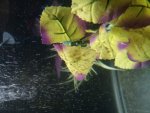Sylerwin
New member
I currently have 3 adult (~8") axolotls in a 40 gallon breeder tank. I have a filter that's for up to 55 gallons, and it's aerated. A while back, I had this HORRIBLE bout of planaria that I COULD NOT get rid of. I got really busy and wasn't able to keep up with cleaning up their poop so I recently removed the sand from their tank. Not having sand makes cleaning easier so I do it more often--however, I'm no longer seeing axie "turds" ...all I see is this brown waste really loose, and it makes it really hard to clean. Especially if I spook an axolotl and they dash out of there, stirring up all the waste. I also have what *appears* to be dead worms ALL. OVER. EVERYTHING. I'm assuming that now that the plants and sand are gone, the planaria have nothing to feed on so they're dying off? They can't be eating uneaten food, my axolotls swallow a whole worm each.
My tank is disgusting, and it's an eye-sore in my house. I want to clean all the decor and stuff, but I don't want to kill the beneficial bacteria. If I'm still having this issue later on, I'm debating on getting more sand to put back in the tank, it's ugly without it :/
1. Are these small, brown, string-like things stuck on everything dead planaria?
2. Why am I never seeing axolotl turds?
3. Should I add sand back in?
Thanks.
My tank is disgusting, and it's an eye-sore in my house. I want to clean all the decor and stuff, but I don't want to kill the beneficial bacteria. If I'm still having this issue later on, I'm debating on getting more sand to put back in the tank, it's ugly without it :/
1. Are these small, brown, string-like things stuck on everything dead planaria?
2. Why am I never seeing axolotl turds?
3. Should I add sand back in?
Thanks.


